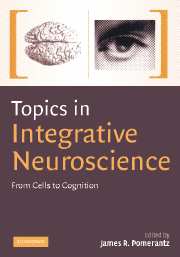Book contents
- Frontmatter
- Contents
- List of contributors
- Preface
- Overview of neuroscience, choice and responsibility
- 1 Neuroscience, choice and responsibility
- PART I HIGHER ORDER PERCEPTION
- PART II LANGUAGE
- PART III MEMORY SYSTEMS
- Introduction to Memory Section
- 9 Memory systems
- 10 A brain system for declarative memory
- 11 The role of the lateral nucleus of the amygdala in auditory fear conditioning
- 12 On crucial roles of hippocampal NMDA receptors in acquisition and recall of associative memory
- PART IV SENSORY PROCESSES
- Index
- Plate section
- References
11 - The role of the lateral nucleus of the amygdala in auditory fear conditioning
Published online by Cambridge University Press: 08 August 2009
- Frontmatter
- Contents
- List of contributors
- Preface
- Overview of neuroscience, choice and responsibility
- 1 Neuroscience, choice and responsibility
- PART I HIGHER ORDER PERCEPTION
- PART II LANGUAGE
- PART III MEMORY SYSTEMS
- Introduction to Memory Section
- 9 Memory systems
- 10 A brain system for declarative memory
- 11 The role of the lateral nucleus of the amygdala in auditory fear conditioning
- 12 On crucial roles of hippocampal NMDA receptors in acquisition and recall of associative memory
- PART IV SENSORY PROCESSES
- Index
- Plate section
- References
Summary
Introduction
Classical fear conditioning is a form of associative learning in which subjects are trained to express fear responses to a neutral conditioned stimulus (CS) that is paired with an aversive unconditioned stimulus (US). As a result of such pairing, the CS comes to elicit behavioral, autonomic, and endocrine responses that are characteristically expressed in the presence of danger (Blanchard & Blanchard, 1969; Bolles & Fanselow, 1980; Smith et al., 1980). Fear conditioning has emerged as an especially useful behavioral model for investigating the neurobiological mechanisms of learning and memory, because fear memories are rapidly acquired and long-lasting, involve well-defined stimuli and responses, and depend upon similar neural circuits in different vertebrate species (see Davis & Lee, 1998; LeDoux, 2000; Maren, 1999; Rogan et al., 2001).
In this chapter, we review studies that have investigated the role of the amygdala in fear learning. We argue that neural plasticity in the lateral amygdala is critical for storing memories of the association between the CS and US during fear conditioning, and discuss how learning and memory are achieved at the cellular or molecular level. Alternative views of amygdala contributions to fear conditioning are also considered.
The amygdala and fear conditioning
Fear learning depends critically upon the amygdala (Davis & Shi, 2000; Fendt & Fanselow, 1999; LeDoux, 1996, 2000), a cluster of nuclei in the brain's temporal lobe that plays a key role in regulating emotions (Kluver & Bucy, 1939; LeDoux, 1996).
- Type
- Chapter
- Information
- Topics in Integrative NeuroscienceFrom Cells to Cognition, pp. 299 - 325Publisher: Cambridge University PressPrint publication year: 2008



